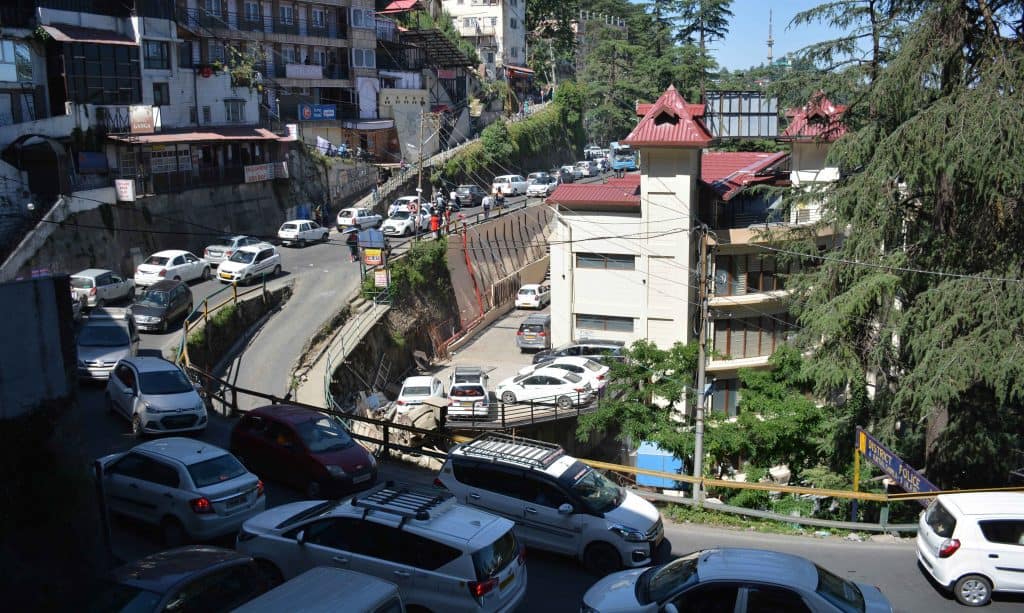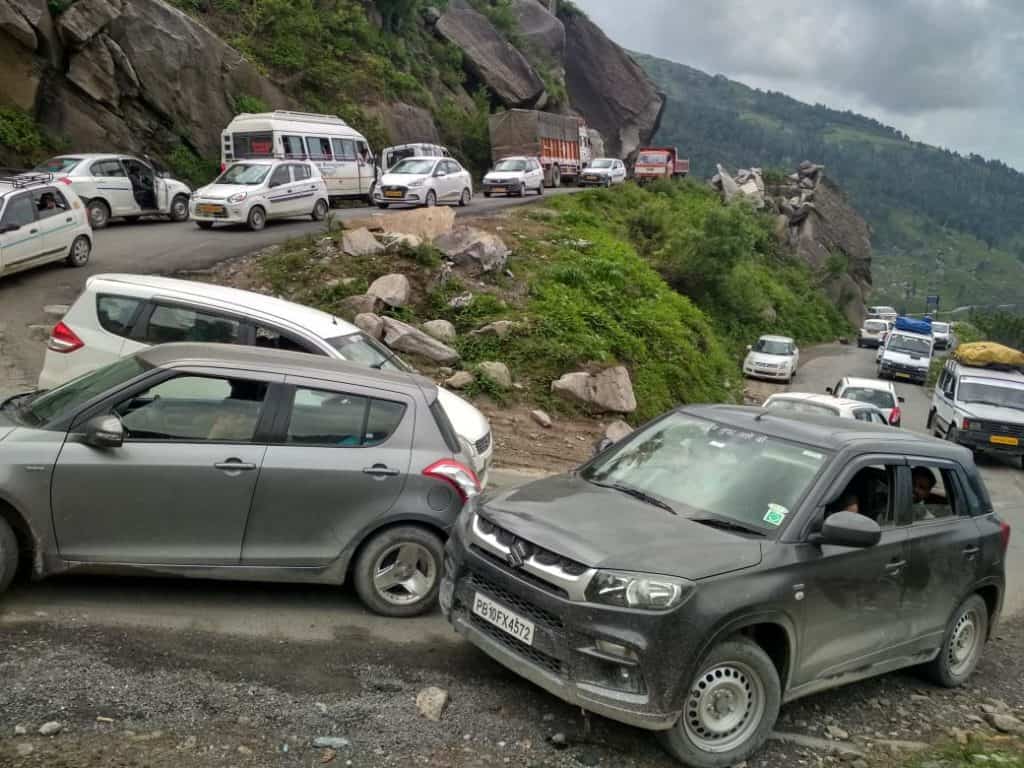“We began the tourist season on a happy note, mid-way we crumbled,” says Anup Thakur, President Manali Hoteliers Association. “Highways got choked, the 40-45 km Kullu–Manali road turned into a nightmare, while the administration slept through it all”.
Unprecedented summer heat in the northern plains saw tourists flocking to Shimla, British India’s winter capital, in search of a cooler haven. The other popular tourist destination, Kullu-Manali, with its scenic drive to the 13059-feet high Rohtang Pass got crowded too. And while the rush was a boon for hoteliers and the state’s tourism industry, for visitors and locals alike, it proved to be chaos.
The state’s highways were never designed to take this load. Five to eight-hour traffic jams became a common daily sight on the Shimla-Parwanoo National Highway, Kullu-Manali road and Manali-Rohtang Pass Highway. Many Rohtang bound tourists, even those heading for Shimla, called off their journey midway. “Over-tourism”, and its attendant problems, had suddenly become a grim reality.
“I thought Shimla will provide some relaxation and escape from furnace-like, overcrowded Delhi,” said a disappointed Vivek Sharma, a Noida businessman. “It was a disappointment to see such traffic jams and rush. Barring its cool climate, Shimla doesn’t offer great respite anymore during peak summers”.
Thankfully, this year Shimla had no drinking water problem unlike in 2018 when water taps went dry for eight days. That in itself was one reason for the high tourist influx. Weekends in particular have been seeing a “full house” situation, forcing the local administration to close down schools on Saturdays in June and reschedule their working hours subsequently in order to manage traffic movement on Shimla’s circular or ‘cart–road’.
“This was a last resort decision during peak tourist days,” said Deputy Commissioner, Shimla, Amit Kashyap. “We had to close schools on weekends when arrivals saw a four-fold increase and we were unable to cope with the rush and traffic movement”.
Kashyap also blamed the badly designed and poorly constructed new parking lots in the town which, he said, caused more obstructions instead of offering solutions. A new multi-storied parking lot built at the entry to Shimla town is not used by tourist vehicles, as there is no public transport connectivity into town from there. Hence every tourist vehicle has to enter the city, adding to their own and citizen’s problems.
Overtourism problems
Though the peak season is coming to a close with the opening of schools in the plains after summer break and some relief from the heat wave, weekend arrivals continue to be high, especially as the Delhi government has extended the school summer break by one week. The average summer season tourist arrivals per day in Shimla, as estimated by the tourism department, is between 6000 and 6500. Early arrivals usually begin in May, but the Lok Sabha elections pushed back tourist arrivals to after May 25th this year.
Almost 1000 to 1500 tourist vehicles enter Shimla every day and the number goes up to 2500-3000 during the peak June season. On weekends, the number of tourists increases to 15000 to 20000 a day. And if it is an extended weekend break, overcrowding far exceeds the town’s carrying capacity.
To add to the above, it must be remembered that the town set-up by the Britishers for a population of 30000 has witnessed an explosion in population with the number touching 2.3 lakh. Add the tourists who number 20,000 on peak summer days, and the hundreds of visitors entering Shimla from the peripheral towns including those who travel to the city on work or private engagements, the figure easily touches almost three lakh on some days.
“This is overtourism–a term now getting increasing attention in many tourist places in the world,” said Prof Sonia Khan, Director Vocational (Tourism) studies at Himachal Pradesh university. “We are creating a disaster like situation in an eco-fragile state. Overtourism goes against the principles of a sustainable tourism economy. We neither have the roads nor basic infrastructure or civic amenities to cope with it. This is not going to benefit the state or its people in long run.” The tourists too have started feeling the adverse effects of overcrowding: prolonged traffic snarls, choked highways, overflowing parking places and packed hotels.
The worst affected is the ecologically fragile Rohtang Pass, with crowds becoming totally unmanageable, and sometimes unruly too. In 2015, the NGT had imposed a total ban on all tourism activities at Rohtang Pass. But despite that, 5000 to 6000 tourists visit the Pass every day during the peak season. The NGT has now ordered that not more than 1200 tourists vehicles, 800 of these petrol and 400 diesel, will be permitted per day. To ensure this, all tourist vehicles headed for Rohtang Pass need a valid permit, available online.
But the regulation is neither fool-proof nor free from corruption involving police and officials who are supposed to enforce the NGT measures. There are reports that 3000 to 3500 vehicles reach Rohtang Pass daily, causing total chaos on the road. Traffic jams of six to seven hours on this road is normal on peak days. One reason for the rush was that Rohtang Pass saw upto 25 to 30 feet of snow this year, bringing in tourists but with devastating consequences for the environment.
Ecological damage
The damage such large tourist numbers cause to the mountain ecology can be severe. Clearing the huge garbage, disposable food packets, plastic bottles, cups and other food waste dumped by tourists is an issue. High vehicle emissions not only raise temperature, causing faster snow-melting, but also blacken the surface of the snow and glaciers there.

Traffic in the streets of Shimla. Vehicle emissions are one of the biggest concerns in the tourist season. Pic: Pradeep Kumar
“We will not allow Rohtang Pass to die a slow death,” said Govinder Thakur, minister for forest and transport, who is also Manali MLA. “The pollution and environmental degradation from overtourism will be curbed effectively. Next year, I propose to stop all taxis and other tourist vehicles – both diesel and petrol – at the Marhi base camp. We will only ply electric buses between Marhi and Rohtang Pass”.
Manali Municipal committee officials told us that against the usual daily garbage generation of 10 to 12 tonnes, Manali was generating almost 35 tonnes of garbage a day during May and June.
R K Purthi, member secretary, Himachal Pradesh Pollution Control Board (HPPCB) said that apart from garbage and other forms of pollution that major and minor towns like Shimla and Chail face, overcrowding also severely affects air quality in the town, mainly from increase in vehicle emissions. “We analysed the data collected at different observatories in Shimla in particular during May and June this year,” said Purthi. “There was substantial deterioration in ambient air quality especially on weekend and holidays”.
Sanjay Sood, President of Hoteliers Association agrees that there is a dire need for dispersal of tourism and supports a strict regulatory mechanism for all stakeholders—-tourists, hoteliers and those engaged in the tourism industry. He advises those planning a weekend trip to Shimla to book accommodation in advance to avoid inconvenience to citizens.
Dispersal plans
About 1.65 crore tourists visit Himachal every year, with foreigners numbering four to five lakh. The highest number of tourist arrivals, 1.84 crore, was in 2016. This year, Himachal had already got 35.73 lakh tourists till March. The figures for April-May-June are expected to raise the total number to nearly one crore, feel tourism officials.
Tourism is a major revenue earner for the state and constitutes 6.7 percent of the state’s GDP. Total earnings from the sector is approximately Rs 10,000 crore, with more than one lakh people directly or indirectly earning livelihoods from it.
“We propose to go in for major investments in the sector, attracting big hotel chains and hospitality companies,” said Ram Subhag Singh, Additional Chief Secretary (Tourism). “By rough estimates, we shall see an investment of Rs 1500 to Rs 2000 crore. And all new investments will be in unexplored, new areas to see a dispersal from overexploited hill stations.”
Dispersal, alone, may not completely reverse the damage though. While some regulatory measures have been taken, these need to be enforced. Despite complete ban on plastics, which also include disposable cups and plates, tourists are still taking such items to Rohtang Pass, adding to the waste left behind. Make-shift dhabas (eateries), unauthorised structures for tea-stalls or garment selling points also have an impact on the environment.
The state government did introduce electric buses three years back, but the numbers need to be increased. More needs to be done to increase awareness and encourage tourists to use public transport, many of whom opt to take their own vehicles for adventure.
Dr R.K Singh, head of G.B. Pant National Institute of Himalayan Environment & Sustainable Development at Kullu, feels that there is an urgent need to divert tourists to new destinations. “Why should everyone visit Rohtang Pass? Dispersal is a simple way to reduce congestion and overuse,” he says.
However, he adds, “The regulatory mechanism has to be very strict at the same time, both about number of tourists vehicles and activities permitted at Rohtang. We are also party to NGT’s expert panel. Some of the recommendations made by the panel to check environmental degradation are yet to be enforced. The vehicles reaching Rohtang Pass every day are much higher than the number fixed by NGT. People are taking benefit of the loopholes in the system.”
Yunus, Director, Tourism and Civil aviation also talks about dispersal of tourism activity to new areas to take the load off over-saturated places like Shimla, Manali, McLeodganj, Dalhousie and Kasauli. “We are focusing on new ropeway projects,” he said. “Promotion of lesser known places and integrating culture, handicrafts, cuisines, fairs and festivals and some adventure activities with tourism are being considered as the new thrust areas, so that tourists should not look only at Shimla and Manali”.
But till that happens, the state’s famous tourism promotion line from a 1970 film song sung by Mohammad Rafi, “Tum Mujhe Yun Bhula Na Paoge” will probably hold true, but for all the wrong reasons.

So many tourist visit these places but there is no proper toilet facilities. Why no media also pin point it. Even if there is toilet it is not being maintained.